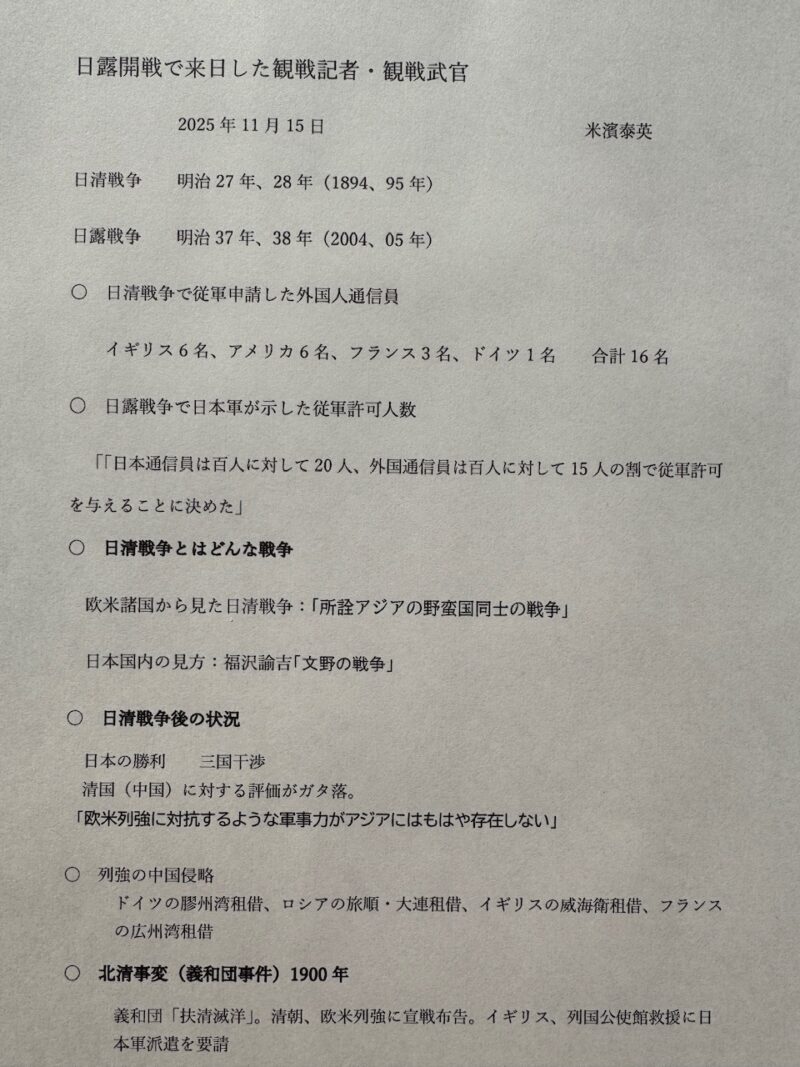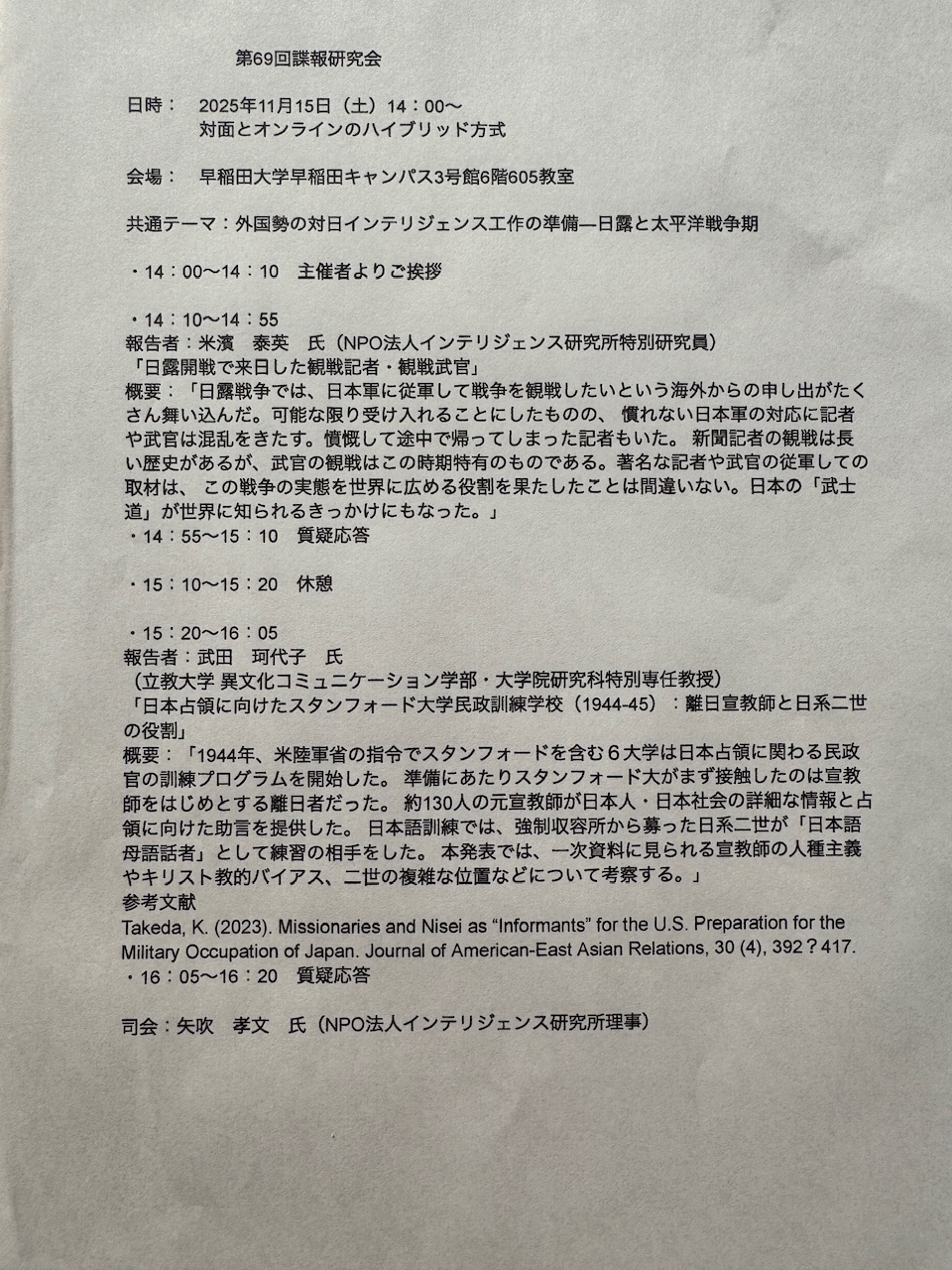11月15日(土)、東京・早稲田大学で開催された第69回諜報研究会(NPOインテリジェンス研究所主催、早稲田大学20世紀メディア研究所共催)に参加して来ました。前回の第68回が開催されたのは7月でしたから、実に4カ月ぶりです。正直に言いますと、この会にはもう何十回も参加しており、マンネリ感がありましたが(失礼!)、久しぶりの参加で気分が一新して、新鮮な気持ちで参加できました(笑)。
何しろ、誰でも分け隔てなく無料で参加出来るのですからね。インテリジェンス研究所の会員登録者は2500人もいらっしゃるといいますから、それだけ関心の高い人が多いということです。特に、最近は、高市新政権となって、首相は、スパイ防止法制定に意欲的で、国家情報局の創設まで検討しています。インテリジェンスの「歴史」も大切ですが、こういった「最新情報」に精通した専門家をお呼びしてお話を聞きたいなあ、と思いました。我々の身近な問題ですからね。
本日は、前置きが長くなりましたが、第69回の共通テーマは「外国勢の対日インテリジェンス工作の準備―日露と太平洋戦争期」で、お二人の講師が登壇しました。
米濱泰英氏「日露開戦で来日した観戦記者・観戦武官」
最初の報告者は、米濱泰英・インテリジェンス研究所特別研究員で、テーマは「日露開戦で来日した観戦記者・観戦武官」でした。米濱氏は会場参加ではなく、オンライン参加でした。そのため、主催者側の方が気を利かして、会場に設置した「共有画面」は映画のように暗くした方が見やすいと判断されたのか、室内の電気を消されてしまいました。
こっちは、このブログを書くために、一生懸命にメモを取っているわけですから、暗くなるとメモが取りづらい!おまけに暗いと眠くなってしまいました(笑)。
本日は脱線ばかりして変ですね。失礼致しました。

米濱氏の報告で一番興味深かった話は、日露戦争(1904〜05年)で、事前に海外列強国は「ロシアの圧勝」を予想し、国内でも政治家や軍人らは「日本は不利で勝ち目は薄い」と予想し、満州軍総参謀長の児玉源太郎でさえ「どう見ても不利、せめて最終的にトントンに持っていければ良い方だ」と判断していたといいます。それなのに、どういうわけか、米国のセオドア・ローズベルト大統領だけは日本の勝利を予言していたというのです。彼は、米陸海軍からのデータを精査してそう判断したらしいのですが、そのことを同大統領は、ハーバード大学の同期生で、第4次伊藤博文内閣で司法相も務め、特使として米国に滞在していた金子堅太郎に語り、これを金子が暗号電報で、小村寿太郎外相に打電し、この電報を見た日本の閣僚や元老たちは大喜びしたといいます。
米濱氏によると、日露戦争後のポーツマス講和会議の際に仲介役を務めたローズベルト大統領が、どちらかと言えば日本贔屓だったのは、金子に勧められた新渡戸稲造著「武士道」を読んだからではないかといいます。ローズベルト大統領は、すぐ読んですっかり武士道の虜になり、この本をさらに30部も取り寄せて、5人の子供や親戚、上下両院議員らに送って読むように勧めたというのです。
しかし、ポーツマス条約で、ロシアから賠償金を取れなかったことで、日本国内で日比谷焼打事件などが起こった様子を見聞したローズベルト大統領は、日本人の傲慢な居丈高さについて友人に手紙を書いたりして、すっかり「日本熱」は冷めてしまったらしいのですが…。
これは、日本は「秘密主義」で、引き分けに近い薄氷の勝利だったのにも関わらず、政府も新聞も正確な情報を民衆(国民)に伝えなかったことが原因でした。
武田珂代子氏「日本占領に向けたスタンフォード大学民政訓練学校(1944-45):離日宣教師と日系二世の役割」
次に登壇されたのは、立教大学異文化コミュニケーション学部・大学院研究科特別専任教授の武田珂代子氏で、演題は「日本占領に向けたスタンフォード大学民政訓練学校(1944-45):離日宣教師と日系二世の役割」でした。
民政訓練学校(CATS=Civil Affairs Training School)とは、戦後の日本占領を見据えて、その準備と民政官の訓練のために米陸軍省によってつくられた教育機関です。既に1942年5月に米バージニア大学内に軍政学校が創設され、44年にはハーバード、イエール、シカゴなど六つのエリート大学内にCATSがつくられました。武田氏の報告は、演題にある通り、この6大学のうちの一つであるスタンフォード大学のCATSに採用された日系二世と離日宣教師の果たした役割を考察したものでした。

武田氏の調査によると、スタンフォード大学のCATSに採用された日系二世は23人で、単なる「機械的な」日本語会話の練習相手のみで、文法や日本の地理や政治などのエリアスタディの担当は許されなかったそうです。それでも、彼らがCATSに応募したのは、強制収容所に収容されていたため、故郷のカリフォルニア州に戻れることや日本語能力の要求度が高くなく、評価できる監督者もいないなどといった理由が考えられるようでした。
離日宣教師による情報提供と助言は、かなり濃度の高いものでした。日本の社会福祉や緊急事態(災害、騒乱など)に関する14の質問に対して約130人が詳細に回答し、中には、日露戦争後の日比谷焼打事件や、排日移民法(1924年)抗議デモや、関東大震災時のデマや朝鮮人虐殺、日本人の多くが知らなかった中国や朝鮮での日本軍による残虐行為まで語る宣教師がいたといいます。
これら全てが戦後の占領政策に生かされます。CATSで訓練を受けたのは、陸軍情報部(MIS)の軍人やCIAの前身のOSS(戦略情報局)の局員たちでしたが、彼らは戦後、主にGHQの民政局などで活動します。
敵性語を禁止した大日本帝国とはえらい違いですよね。米国は、真珠湾攻撃の半年後のミッドウェー海戦で、既に勝利を確信して戦後処理の占領政策に早くも着手しています。こうした日本語のスペシャリストを養成するだけではなく、東京空爆の際には、占領統治のために、GHQ本部にする第一生命本社ビルの空爆は避け、娯楽施設の日比谷の宝塚劇場や銀座の松屋、三越、松坂屋を残し、明石町の聖路加病院を保護したりしています。
竹槍で本土決戦を戦おうとしていた日本人には全く想像できなかったことです。勇ましく開戦した軍部(大本営)の中で、事前に戦後処理に関して構想した軍幹部は皆無だったのではないでしょうか。
Preparations for Foreign Powers’ Intelligence Operations Against Japan – During the Russo-Japanese and Pacific War Periods=The 69th Intelligence Study Group Report
I attended the 69th Intelligence Study Group (hosted by the NPO Institute of Intelligence, co-hosted by Waseda University’s 20th Century Media Research Institute) held at Waseda University in Tokyo on Saturday, November 15. Since the 68th session was held in July, this was a gap of four months. To be honest, I have attended this group countless times and felt a sense of routine, but the long-awaited return refreshed my mood, and I was able to participate with a new sense of excitement (lol).
After all, anyone can participate for free without discrimination. The Institute of Intelligence reportedly has 2,500 registered members, indicating a high level of public interest. Especially recently, with the new Takaichi administration, the Prime Minister is enthusiastic about enacting an Anti-Espionage Law and is even considering the establishment of a National Intelligence Agency. While the “history” of intelligence is important, I felt a strong desire to invite and listen to experts who are well-versed in this kind of latest information. These are issues close to our daily lives.
Apologies for the long prelude today. The common theme for the 69th session was “Preparations for Foreign Powers’ Intelligence Operations Against Japan – During the Russo-Japanese and Pacific War Periods,” and two speakers took the stage.
Yasuhide Yonehama: “War Correspondents and Military Attachés Who Came to Japan at the Outbreak of the Russo-Japanese War”
The first presenter was Mr. Yasuhide Yonehama, a special researcher at the Institute of Intelligence, whose theme was “War Correspondents and Military Attachés Who Came to Japan at the Outbreak of the Russo-Japanese War.” Mr. Yonehama participated online rather than in person. Consequently, the organizers, perhaps judging that the “shared screen” set up in the venue would be easier to see if the room was darkened like a movie theater, turned off the lights.
Since I was diligently taking notes to write this blog, it became difficult to do so in the dark! Furthermore, the darkness made me sleepy (lol).
My tangents today are strange. I apologize.
The most interesting part of Mr. Yonehama’s report was about the Russo-Japanese War (1904–05). Before the war, major foreign powers predicted a “landslide victory for Russia.” Domestically, politicians and military figures also anticipated that “Japan is at a disadvantage with slim chances of winning.” Even General Gentarō Kodama, Chief of Staff of the Manchurian Army, concluded, “It looks unfavorable in every respect; the best we can hope for is an eventual stalemate.” Yet, for some reason, only U.S. President Theodore Roosevelt predicted a Japanese victory. He reportedly made this judgment after carefully examining data from the U.S. Army and Navy. He confided this to Kentarō Kaneko, his Harvard classmate who had served as Minister of Justice in the 4th Itō Hirobumi Cabinet and was staying in the U.S. as a special envoy. Kaneko then sent this information via coded telegram to Foreign Minister Jutaro Komura, and Japanese cabinet members and Elder Statesmen were reportedly overjoyed upon seeing the telegram.
According to Mr. Yonehama, President Roosevelt, who mediated the Portsmouth Peace Conference after the Russo-Japanese War, was rather pro-Japanese because he had read “Bushido: The Soul of Japan” by Inazō Nitobe, recommended by Kaneko. President Roosevelt immediately read it, became completely captivated by Bushido, and even ordered 30 more copies to send to his five children, relatives, and members of both the Senate and House of Representatives, urging them to read it.
However, after witnessing the Hibiya Riot and other incidents in Japan following the Portsmouth Treaty, triggered by Japan’s failure to secure an indemnity from Russia, President Roosevelt’s “Japan fever” apparently cooled completely, as he wrote letters to his friends expressing his frustration with the “arrogant and overbearing” attitude of the Japanese people. This was caused by Japan’s “secrecy,” where neither the government nor the newspapers accurately conveyed information to the public, despite the victory being a close, tenuous one, almost a draw.
Kayoko Takeda: “Stanford University’s Civil Affairs Training School (1944–45) for the Occupation of Japan: The Role of Missionaries Returning from Japan and Nisei”
Next to present was Ms. Kayoko Takeda, a specially-appointed professor at the College and Graduate School of Intercultural Communication at Rikkyo University. Her presentation was titled, “Stanford University’s Civil Affairs Training School (1944–45) for the Occupation of Japan: The Role of Missionaries Returning from Japan and Nisei.”
The Civil Affairs Training School (CATS) was an educational institution established by the U.S. War Department to prepare for and train civil affairs officers for the post-war occupation of Japan. A Military Government School had already been established at the University of Virginia in May 1942, and by 1944, CATS were created within six elite universities, including Harvard, Yale, and Chicago. As the title suggests, Ms. Takeda’s report examined the roles played by Nisei (second-generation Japanese Americans) and missionaries returning from Japan who were recruited into the CATS at Stanford University, one of the six institutions.
Ms. Takeda’s research revealed that the 23 Nisei adopted into the Stanford CATS were merely for “mechanical” Japanese conversation practice. They were not permitted to be in charge of area studies, such as grammar, Japanese geography, or politics. It is thought that they applied to CATS due to reasons such as being able to return to their hometown of California after being held in internment camps, the requirement for Japanese ability not being overly demanding, and the absence of highly critical supervisors.
The information and advice provided by the missionaries returning from Japan were highly concentrated. Approximately 130 people provided detailed answers to 14 questions regarding Japanese social welfare and emergencies (disasters, riots, etc.). Some missionaries even spoke about the Hibiya Riot after the Russo-Japanese War, protests against the Exclusion Act of 1924, rumors and massacres of Koreans during the Great Kanto Earthquake, and even the atrocities committed by the Japanese military in China and Korea, which many Japanese were unaware of.
All of this information was used in the post-war occupation policy. Those trained at CATS included military personnel from the Military Intelligence Service (MIS) and agents from the OSS (Office of Strategic Services), the predecessor of the CIA, who would later primarily work in the Civil Affairs Section of GHQ.
This is a huge contrast to the Empire of Japan, which banned “enemy languages.” The U.S., already confident of victory after the Battle of Midway, six months after the Pearl Harbor attack, quickly began working on post-war occupation planning. Not only did they train Japanese language specialists, but during the Tokyo firebombing, they specifically avoided bombing the Dai-Ichi Life Insurance building (to be GHQ headquarters for occupation governance), spared entertainment facilities like the Takarazuka Theatre in Hibiya and department stores like Matsuya, Mitsukoshi, and Matsuzakaya in Ginza, and protected St. Luke’s International Hospital in Akashicho.
This was completely unimaginable to the Japanese people, who were being prepared to fight a final mainland battle with bamboo spears. It is highly likely that there were no military executives within the courageous military command (Imperial General Headquarters) who had conceived of post-war planning beforehand.


コメント